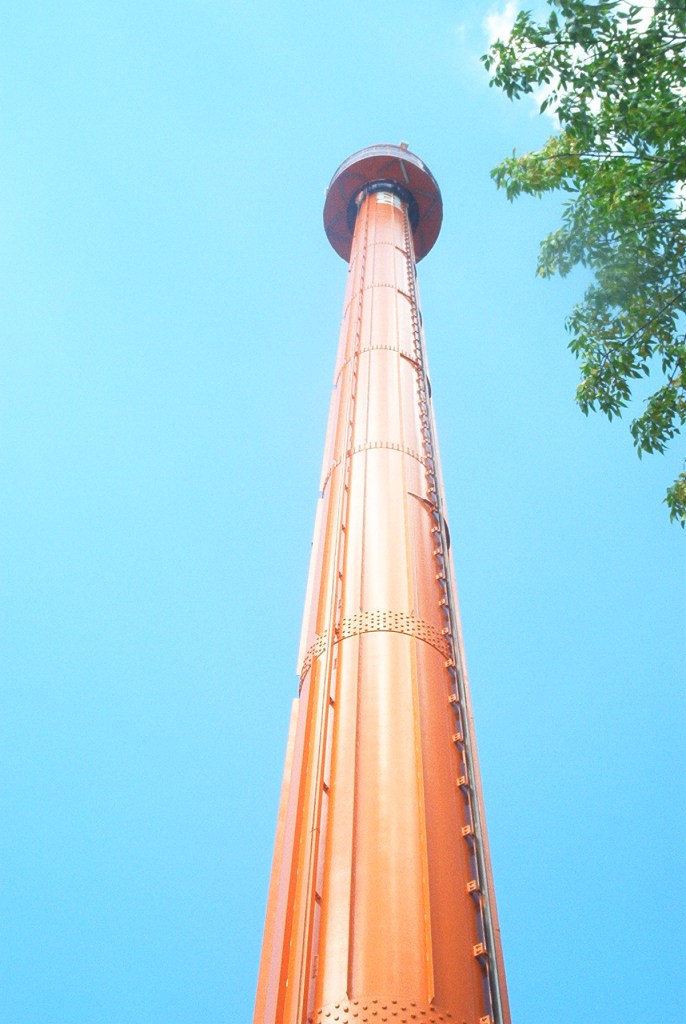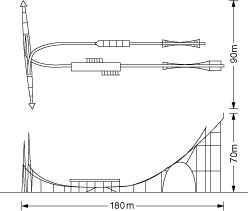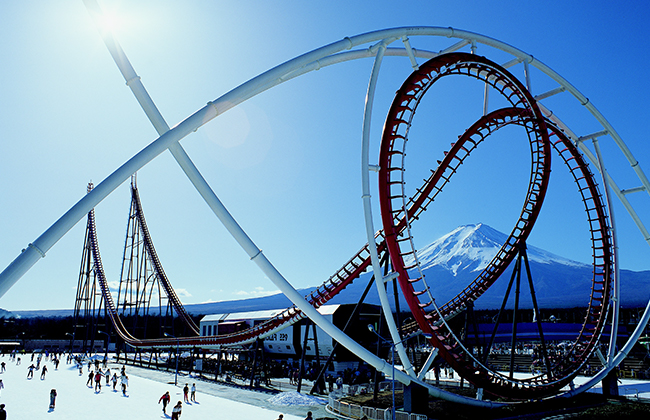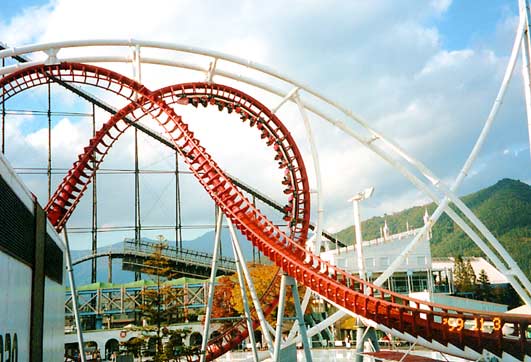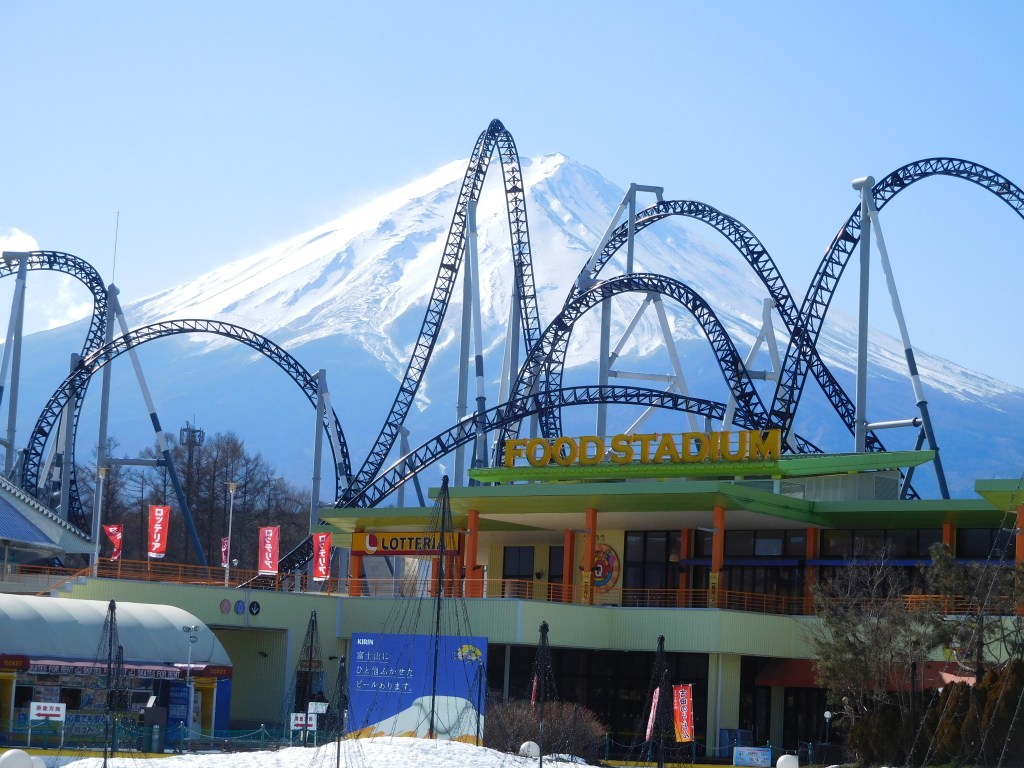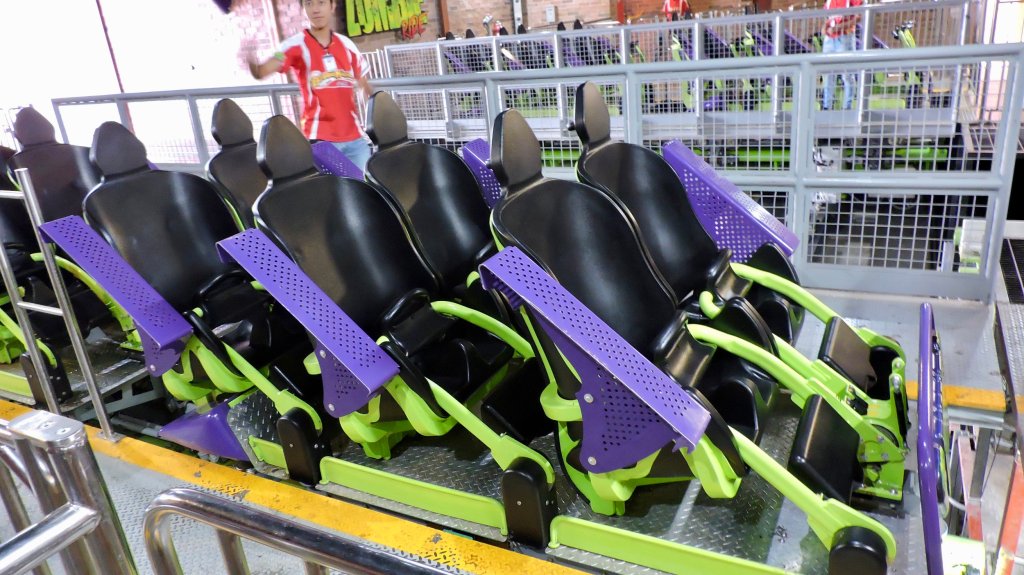Fujikyu Highlands (now Fuji-Q Highland in Fujiyoshida, Japan) worked with Meisho/Sanoyas to build the world’s tallest roller coaster in 1983 as a new shuttle coaster. Taking what Meisho had learned from their Loop The Loop design, Fuji-Q wanted to take guests to the next level: break the 60 meters (196.85 feet) barrier on a roller coaster. Traditional observation towers from Von Roll and Willy Buhler, later sold by Intamin, routinely broke that threshold, in some cases reaching the 300 feet mark. It was seen notably at Cedar Point in Sandusky, OH, Liseberg (Goteborg, Sweden), and Expo 67/La Ronde in Montreal, QC. In all those installations, the tower reached 330-350 feet, including the top’s antenna. For Space Spiral at Cedar Point and Spirale at La Ronde, the dual-level ride car reached the 285 feet mark.
For the new roller coaster at Fuji-Q, Meisho kept the same general idea as their earlier Shuttle roller coaster: catch car to take a train facing forward up the spike before getting released and going through the course backward. It would then have enough potential energy to return to the station. Now, the plot of land they worked with was more of a rectangle than the long narrow strip of land commonly used at the time. The land was near the large outdoor skating rink at the park’s front, making the new roller coaster a dramatic statement and enticed passersby. In total, the ride footprint was 295 feet wide x 590.5 feet long, a massive surface for a shuttle roller coaster then.
The layout was quite shocking: the station on the right side of the ride, with a massive Pretzel Knot in front and two spikes that abruptly curved as they approached the 200 feet level. The track again turned upward in an exaggerated fashion past where the train reached, giving the top of the structure an artistic flair. Those spikes were the record setters, reaching 229.66 feet.
http://coaster.blog90.fc2.com/blog-entry-15.html
Again, the Pretzel Knot continued the smooth architectural flair, with an impressive cantilever steel structure holding it up. With a taller one on the right, two steel towers support two curved sections that hold the track up. It was the portion of the ride that was 295 feet wide.
The boarding station looks like a spaceship from a science-fiction movie, tying in with the attraction name: Moonsault Scramble/ムーンサルトスクランブル. Guests boarded the seven-car train, with four passengers in two rows in each vehicle. The small seats enclosed riders, and a padded shoulder restraint restrained them in.
https://www.fujiq.jp/media/history.html
The experience started with the train rolling forward out of the station and attaching itself to the catch car. Unlike at Rusutsu Resort on their Loop-The- Loop, rubber pieces were not installed on the track ties to prevent the lift cables from rubbing against them. The catch car hooks up with the train and starts pulling it forward up the spike. A particular detail, HL-228, was stenciled on the catch car, visible to riders in the front row. This probably stood for Height Level 228 feet in English, the approximate maximum height the cart and train reached, which translated to 69.49 meters, the height Guinness World Records certified or rounded up to 70 meters according to Meisho diagram above.
http://coaster.blog90.fc2.com/blog-entry-15.html
After a long journey that takes nearly a minute and a half, the cart reached the track section where it was pushed open, releasing the train. It roared backward down the spike, through the station in a hurry. Meisho designed the ride to reach 55.92 mph, but in practice, it was clocked and certified by Guinness World Records to run a blazing 65.2 mph, the fastest steel roller coaster in the world at the time.
When the train exit the station, the track twisted to the left, in the first part of the Pretzel Knot. It passed under the second portion of the Pretzel Knot, creating a true pretzel shape other manufacturers were not building at the time. After briefly reaching the bottom part, it twisted up to the left again, sending the train back toward the direction it came.
Accelerometers revealed a third-world record: the most intense roller coaster. Riders felt an insane 6.5 G’s (6.5 times their weight) in the Pretzel Knot. Where? Looking at where Meisho reinforced the track with additional track ties, the top sections at the top before it dives down toward the ground are a good hint as to where. The bottom section and right half-loop portion also likely candidates for powerful forces.
http://drkssk27.web.fc2.com/zekkyou/fujikyu/moon.html
It roared through a straight section of the track, reaching the second spike. Like the Loop-The-Loop and Atomic Coaster, no catch car or chain was needed to help the train clear the layout forward. Guests climbed the spike, stall, and then plunge forward. This spike was a little shorter than the first one due to all the speed already exhausted.
While the train is going through the course, pairs of drive-tires mounted in the middle of the station’s track move. The train goes through the station forward, loudly braked by pneumatic brake calipers and the station brake tires the first time. It then rolls backward through the station, braked a second time. It is then brought back to a more manageable speed for final braking for its third pass through the station.
One incredible detail we discovered while looking at on-ride videos is the presence of a transfer track in the station building. The reason for such a long station is not just for the tire brakes: a second train was present on the ride and could run alternately. This was a brilliant move given the incredible forces the trains went through and stretched their life. We assessed with videos and photos that the transfer track was managed this way: both tracks have brakes and drive tires mounted on them. Before the park opened to guests, they slid either the left or right train on the track, and that was the one to run that day. In the following video, you can see the empty track on the left side, indicating that the train was taken off the ride for annual maintenance. https://youtu.be/h_ecR2dSbjo?t=102
The ride thrilled riders for nearly 17 years until age, and maintenance caught up to it. The ride was retired in April 2000, to be replaced by two new roller coasters down the line: Dodonpa (now Do-Dodonpa) in 2001 and Takabisha in 2011.
Today, the idea of a transfer track evolved and can now operate two trains on a single track, as seen on Premier Rides Mr. Freeze roller coasters at Six Flags St-Louis (Eureka, MO) and Six Flags Over Texas (Arlington, TX). Those two roller coasters feature two separate loading stations with a train for each. After loading, the track slides toward the center to align with the launch track. While that is going on, the other train goes through its loading process, effectively doubling capacity.
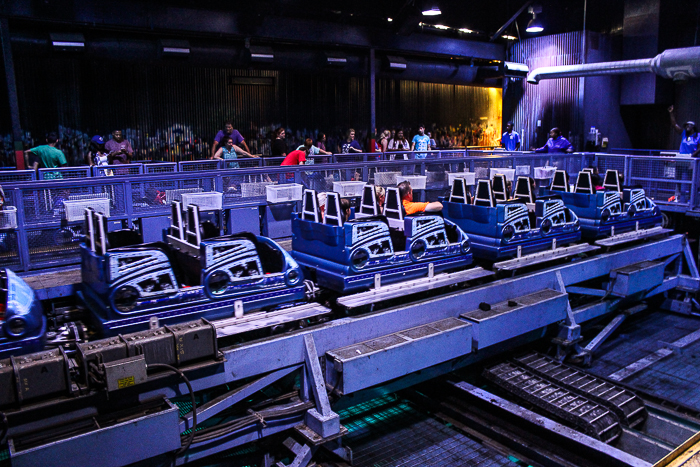
Paul and Bond from Negative-g.com visit Six Flags Over Texas on the final stop of their six day seven park Texas tour to ride Shock Wave, the New Texas Giant, Titan and others.
Later on, Premier applied the same idea to Zombie Ride, a two-train Sky Rocket II roller coaster located at Bosque Magico (Guadalupe, Mexico.) In this case, the Sky Rocket II features a swing launch configuration where the train goes forward, backward, and forward up the front spike. Because the train goes through the station twice during the launch sequence, you were not able to run more than a single train. Using sliding track switches in the attraction station, boosted capacity and extended ride cycle are significant benefits.
Last, Intamin supplied a Reverse Free Fall Coaster to Ferrari World Abu Dhabi in the UAE in 2017. Standing 210 feet tall, this shuttle coaster use two stations with sliding tracks to operate two trains on a single shuttle track.

